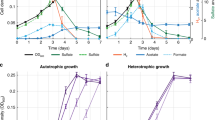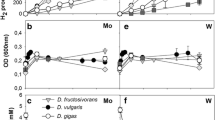Abstract
Desulfovibrio vulgaris (Marburg) was grown on hydrogen plus sulfate as sole energy source and acetate plus CO2 as the sole carbon sources. The incorporation of U-14C acetate into alanine, aspartate, glutamate, and ribose was studied. The labelling data show that alanine is synthesized from one acetate (C-2 + C-3) and one CO2 (C-1), aspartate from one acetate (C-2 + C-3) and two CO2 (C-1 + C-4), glutamate from two acetate (C-1−C-4) and one CO2 (C-5), and ribose from 1.8 acetate and 1.4 CO2. These findings indicate that in Desulfovibrio vulgaris (Marburg) pyruvate is formed via reductive carboxylation of acetyl-CoA, oxaloacetate via carboxylation of pyruvate or phosphoenol pyruvate, and α-ketoglutarate from oxaloacetate plus acetyl-CoA via citrate and isocitrate. Since C-5 of glutamate is derived from CO2, citrate must have been formed via a (R)-citrate synthase rather than a(S)-citrate synthase. The synthesis of ribose from 1.8 mol of acetate and 1.4 mol of CO2 excludes the operation of the Calvin cycle in this chemolithotrophically growing bacterium.
Similar content being viewed by others
References
Alvarez, M., Barton, L.: Evidence for the presence of phosphoriboisomerase and ribulose-1,5-diphosphate carboxylase in extracts of Desulfovibrio vulgaris. J. Bacteriol. 131, 133–135 (1977)
Andrew, I. G., Morris, J. G.: The biosynthesis of alanine by Clostridium kluyveri. Biochim. Biophys. Acta 97 176–179 (1965)
Aronoff, S.: Techniques of radiobiochemistry, p. 141. Iowa: Iowa State College Press 1956
Badziong, W., Thauer, R. K., Zeikus, J. G.: Isolation and characterization of Desulfovibrio growing on hydrogen plus sulfate as the sole energy source. Arch. Microbiol. 116, 41–49 (1978)
Badziong, W., Thauer, R. K.: Growth yields and growth rates of Desulfovibrio vulgaris (Marburg) growing on hydrogen plus sulfate and hydrogen plus thiosulfate as the sole energy sources. Arch. Microbiol. 117, 209–214 (1978)
Balch, W. E., Schobert, S., Tanner, R. S., Wolfe, R. S.: Acetobacterium, a new genus of hydrogen-oxidizing carbon dioxidereducing anacrobes. Int. J. Syst. Bacteriol. 27, 355–361 (1977)
Bray, G. A.: A simple efficient liquid scintillator for counting aqueous solutions in a liquid scintillation counter. Anal. Biochem. 1, 279–285 (1960)
Bryant, M. P., Tzeng, S. F., Robinson, I. M., Joyner, A. E.: Nutrient requirements of methanogenic bacteria. In: Anaerobic treatment processes. Advances in chemistry. Vol. 105 (F. G. Pohland, ed.), pp. 23–40. Washington, D.C.: Amer. Chem. Soc. 1971
Bryant, M. P., Wolin, E. A., Wolin, M. J., Wolfe, R. S.: Methanobacterium omelianskii, a symbiotic association of two species of bacteria. Arch. Microbiol. 59, 20–31 (1967)
Buchanan, B. B.: Ferredoxin and carbon assimilation. In: Iron sulfur proteins, Vol. 1 (W. Lovenberg, ed.), pp. 129–150 New York-London: Academic Press 1973
Cutinelli, C., Ehrensvärd, G., Höström, G., Reio, L., Saluste, E., Sternholm, R.: Acetic acid metabolism in Rhodospirillum rubrum under anaerobic conditions. Ark. Kem 3, 501–509 (1951)
Decker, K., Thauer, R. K., Jungermann, K.: Die Kohlenhydratsynthese in Clostridium kluyveri. I. Isotopenversuche zur Biosynthese der Ribose. Biochem. Z. 345, 461–471 (1966)
Decker, K., Jungermann, K., Thauer, R. K.: Energy production in anaerobic organisms. Angew. Chem. Int. Ed. Engl. 9, 138–158 (1970)
Ehrenberg, L., Fedoresak, I., Solymosy, F.: Diethyl pyrocarbonate in nucleic acid research. In: Progress in nucleic acid research and molecular biology (W. E. Cohn, ed.), pp. 189–262 New York: Academic Press 1976
Evans, M. C. W., Buchanan, B. B., Arnon, D. I.: A new feredoxin-dependent carbon reduction cycle in a photosynthetic bacterium. Proc. Nat. Acad. Sci. 55, 928–934 (1966)
Fuchs, G., Stupperich, E., Thauer, R. K.: Acetate assimilation and the synthesis of alanine, aspartate and glutamate in Methanobacterium thermoautotrophicum. Arch. Microbiol. 117, 61–66 (1978)
Fuchs, G., Stupperich, E.: Evidence for an incomplete reductive carboxylic acid cycle in Methanobacterium thermoautotrophicum. Arch. Microbiol. 118, 121–125 (1978)
Gottschalk, G.: The stereospecificity of the citrate synthase in sulfate-reducing and photosynthetic bacteria. Eur. J. Biochem. 5, 346–351 (1968)
Gottschalk, G., Barker, H. A.: Synthesis of glutamate and citrate by Clostridium kluyveri. A new type of citrate synthase. Biochemistry 5, 1125–1133 (1966)
Hoare, D. S.: The photoassimilation of acetate by Rhodospirillum rubrum. Biochem. J. 87, 284–301 (1963)
Hoare, D. S., Gibson, L.: Photoassimilation of acetate and the biosynthesis of amino acids by Chlorobium thiosulfatophilum. Biochem. J. 91, 546–559 (1964)
Hohorst, H. J.: L-(±)-Lactat-Bestimmung mit Lactat-Dehydrogenase und NAD. In: Methoden der enzymatischen Analyse, Vol. 2 (H. U. Bergmeyer, ed.), pp. 1425–1429, Weinheim: Verlag Chemie 1970
Kelly, D. P.: Autotrophy: Concepts of lithotrophic bacteria and their organic metabolism. Ann. Rev. Microbiol. 25, 177–210 (1971)
Kemble, A. R., MacPherson, H. T.: Determination of monoamino monocarboxylic acids by quantitative paper chromatography. Biochem. J. 56, 548–555 (1954)
Knight, M., Wolfe, R. S., Elsden, S. R.: The synthesis of amino acids by Methanobacterium omelianskii. Biochem. J. 99, 76–86 (1966)
Mejbaum, W.: Über die Bestimmung kleiner Pentosemengen insbesondere in Derivaten der Adenylsäure. Hoppe-Syler's Z. Physiol. Chem. 258, 117–120 (1939)
Pfennig, N., Biebl, H.: Desulfuromonas acetoxidans gen. nov. and sp. nov., a new anaerobic, sulfur-reducing acetate-oxidizing bacterium. Arch. Microbiol 110, 3–12 (1976)
Quandt, L., Pfennig, N., Gottschalk, G.: Evidence for the key position of pyruvate synthase in the assimilation of CO2 by Chlorobium. FEMS letters 3, 227–230 (1978)
Roberts, R. B., Abelson, P. H., Cowie, D. B., Bolton, E. T., Britton, R. J.: Studies of biosynthesis in Escherichia coli. Carnegie Institute, Washington (1957)
Rozanova, E. P., Khudyakova, A. L.: A new nonspore-forming thermophilic sulfate-reducing organism, Desulfovibrio thermophilus nov. sp. [Engl. trans..]. Microbiology (USSR) 43, 908–912 (1975)
Simon, H., Floss, H. G.: Anwendung von Isotopen in der Organischen Chemie und Biochemie, Vol. 2, pp. 8–10, pp. 23ff., pp. 55ff. Berlin, Heidelberg, New York. Springer 1967
Smith, A. J., Hoare, D. S.: Specialist phototrophs, lithotrophs, and methylotrophs: a unity among a diversity of procaryotes? Bacteriol. Rev. 41, 419–448 (1977)
Sorokin, Yu. I.: Sources of energy and carbon for biosynthesis in sulfate-reducing bacteria [Engl. Transl.]. Microbiology (USSR) 35, 643–647 (1966a)
Sorokin, Yu: Investigations of the structural metabolism of sulfatereducing bacteria with 14C [Engl. Transl.]. Microbiology (USSR) 35, 806–814 (1966b)
Sorokin, Yu. I.: Role of carbon dioxide in the biosynthesis by sulphate reducing bacteria. Nature 210, 551–552 (1966c)
Stegemann, H.: Bestimmung von Aminosäuren mit dithionit-reduziertem Ninhydrin. Hoppe-Seyler's Z. Physiol. Chem. 319, 102–109 (1960)
Thauer, R. K., Jungermann, K., Decker, K.: A quantitative isotope method for regulation studies of aromatic amino acid synthesis under growth conditions. Eur. J. Biochem. 1, 482–486 (1967)
Tomlinson, N.: Carbon dioxide and acetate utilization by Clostridium kluyveri. II. Synthesis of amino acids. J. Biol. Chem. 209, 597–603 (1954a)
Tomlinson, N.: Carbon dioxide and acetate utilization by Clostridium kluyveri. III. A new path of glutamic acid synthesis. J. Biol. Chem. 209, 605–609 (1954b)
Tomlinson, N., Barker, H. A.: Carbon dioxide and acetate utilisation by Clostridium kluyveri. I. Influence of nutritional conditions on utilisation patterns. J. Biol. Chem. 209, 585–595 (1954)
Vischer, E., Chargaff, E.: The composition of the pentose nucleic acids of yeast and pancreas. J. Biol. Chem. 176, 715–734 (1948)
Weimer, P. J., Zeikus, G.: Acetate assimilation pathway of Methanosarcina barkeri. J. Bacteriol. 137, 332–339 (1979)
Widdel, F., Pfennig, N.: A new anaerobic sporing acetate-oxidizing, sulfate-reducing bacterium, Desulfotomaculum acetoxidans. Arch. Microbiol. 112, 119–122 (1977)
Wolfe, R. S., Pfennig, N.: Reduction of sulfur by spirillum 5175 and syntrophism with Chlorobium. Appl. Environ. Microbiol. 33, 427–433 (1977)
Zeikus, J. G., Fuchs, G., Kenealy, W., Thauer, R. K.: Oxidoreductases involved in cell carbon synthesis of Methanobacterium thermoautotrophicum. J. Bacteriol. 132, 604–613 (1977)
Author information
Authors and Affiliations
Rights and permissions
About this article
Cite this article
Badziong, W., Ditter, B. & Thauer, R.K. Acetate and carbon dioxide assimilation by Desulfovibrio vulgaris (Marburg), growing on hydrogen and sulfate as sole energy source. Arch. Microbiol. 123, 301–305 (1979). https://doi.org/10.1007/BF00406665
Received:
Issue Date:
DOI: https://doi.org/10.1007/BF00406665




